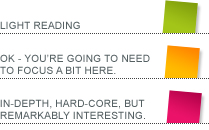Here’s a simple and effective method of getting an idea of what your website should look like, and giving your website designer some direction. It’s called aspirational inspiration. Very basically: you look at brands that your target market aspires to, and look for design elements from those brands and their websites.
Don’t look at your competitor’s websites
Actually, you should look at your competitor’s websites, but only if they are really well designed, which is unlikely. Most websites aren’t badly designed – they just aren’t awesome.
Let’s say you’re a lawyer. If you look at lawyers’ websites – especially law firms in your city, you’re probably going to be looking at some pretty ordinary designs. The other problem with this is that those other law firms aren’t your law firm, so the design of their sites isn’t really going to be just right for you.
The answer is to look at websites for brands that the clients you target aspire to.
 You don’t want a cutting-edge site
You don’t want a cutting-edge site
Adjectives are subjective. If you tell me you want a high-tech, cutting-edge website, you will probably not be happy with what I design for you. Not your fault, and not my fault – it’s just that what I think of as cutting-edge is probably very different from your idea of it.
Adjectives like clean, open, bold and so on are better. If you want something bold I’m not going to use a subtle patterns and delicate fonts. But still – bold could mean ultra-hot pink and lime-green stripes, or it could mean large, thick fonts. So adjectives are good, but they’re subjective. What will work a lot better, and faster, is if you can show the designer examples of what you like, and explain why you think it will work for you.
Examples of aspirational inspiration
Let’s say you’re a property developer and you need a website for the golf course on your development. You have a favourite golf course, so you go to their website. You maybe go to Sergio Garcia’s website, or to Gary Player’s website, seeing as he will be advising on the design of the course. These will give you a mixed bag of designs.
Look at your target market: Let’s say you’re making a very high-end course – course-fees will be astronomical and membership exclusive. Your target market probably drives Jaguar, or Mercedes-Benz. They drink single malt. They own expensive watches. Look at the websites for some of the brands that your target market engage with and aspire to. You’ll probably get a few common elements: Sleek gradients. Serif fonts. Slick animations on menus. Darker colours. Great photography. If you show a designer the best of these sites you’ll get a design that will talk directly to your target market.
Let’s say you are selling a range of homewear – cushions, lamps, and so on, you should find brands that your market think are awesome, and look at their websites for inspiration and design direction.
Be what the client wants
All marketers will tell you that you want your client to feel that you understand them and their needs. Trying to emulate your competitor is not going to make you seem any closer to your client. Aspirational inspiration allows you to take design elements that will appeal to your client and feel familiar to them, placing your business in a mental category that says ‘yes, I want that’. And isn’t that where you want to be?


